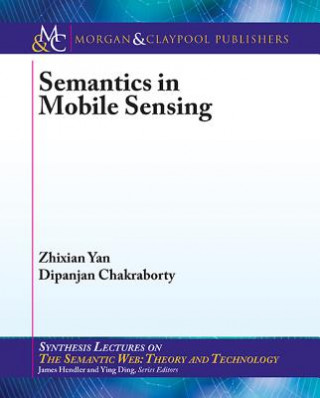
Kód: 08827739
Semantics in Mobile Sensing
Autor Dipanjan Chakraborty
The dramatic progress of smartphone technologies has ushered in a new era of mobile sensing, where traditional wearable on-body sensors are being rapidly superseded by various embedded sensors in our smartphones. For example, a ty ... celý popis
- Jazyk:
 Angličtina
Angličtina - Vazba: Brožovaná
- Počet stran: 143
Nakladatelství: Morgan & Claypool Publishers, 2014
- Více informací o knize

Mohlo by se vám také líbit
-

Dune
249 Kč -

Haunting Adeline
621 Kč -

Berserk Deluxe Volume 2
1092 Kč -

White Nights
71 Kč -

Powerless
268 Kč -

Atomic Habits
330 Kč -

Dune Messiah
228 Kč -

Berserk Deluxe Volume 3
1142 Kč -

One Day
221 Kč -

Berserk Deluxe Volume 1
1115 Kč -

Iron Flame
368 Kč -

Surrounded by Idiots
213 Kč -

Harry Potter and the Prisoner of Azkaban (Minalima Edition)
993 Kč -

Gravity Falls Journal 3
441 Kč -

Heaven Official's Blessing: Tian Guan Ci Fu (Novel) Vol. 1
430 Kč -

The Creative Act
568 Kč -

Dune
276 Kč -

Hunting Adeline
624 Kč -

A Little Life
268 Kč -

Children of Dune
230 Kč -

Heaven Official's Blessing: Tian Guan Ci Fu (Novel) Vol. 2
427 Kč
Informovat o naskladnění knihy
Zadejte do formuláře e-mailovou adresu a jakmile knihu naskladníme, zašleme vám o tom zprávu. Pohlídáme vše za vás.
Více informací o knize Semantics in Mobile Sensing
 Anotace knihy
Anotace knihy
The dramatic progress of smartphone technologies has ushered in a new era of mobile sensing, where traditional wearable on-body sensors are being rapidly superseded by various embedded sensors in our smartphones. For example, a typical smartphone today, has at the very least a GPS, WiFi, Bluetooth, triaxial accelerometer, and gyroscope. Alongside, new accessories are emerging such as proximity, magnetometer, barometer, temperature, and pressure sensors. Even the default microphone can act as an acoustic sensor to track noise exposure for example. These sensors act as a "lens" to understand the user's context along different dimensions. Data can be passively collected from these sensors without interrupting the user. As a result, this new era of mobile sensing has fueled significant interest in understanding what can be extracted from such sensor data both instantaneously as well as considering volumes of time series from these sensors. For example, GPS logs can be used to determine automatically the significant places associated to a user's life (e.g., home, office, shopping areas). The logs may also reveal travel patterns, and how a user moves from one place to another (e.g., driving or using public transport). These may be used to proactively inform the user about delays, relevant promotions from shops, in his "regular" route. Similarly, accelerometer logs can be used to measure a user's average walking speed, compute step counts, gait identification, and estimate calories burnt per day. The key objective is to provide better services to end users. The objective of this book is to inform the reader of the methodologies and techniques for extracting meaningful information (called "semantics") from sensors on our smartphones. These techniques form the cornerstone of several application areas utilizing smartphone sensor data. We discuss technical challenges and algorithmic solutions for modeling and mining knowledge from smartphone-resident sensor data streams. This book devotes two chapters to dive deep into a set of highly available, commoditized sensors---the positioning sensor (GPS) and motion sensor (accelerometer). Furthermore, this book has a chapter devoted to energy-efficient computation of semantics, as battery life is a major concern on user experience.
 Parametry knihy
Parametry knihy
Zařazení knihy Knihy v angličtině Computing & information technology Computer science Artificial intelligence
- Plný název: Semantics in Mobile Sensing
- Autor: Dipanjan Chakraborty
- Jazyk:
 Angličtina
Angličtina - Vazba: Brožovaná
- Počet stran: 143
- EAN: 9781627053907
- ISBN: 9781627053907
- ID: 08827739
- Nakladatelství: Morgan & Claypool Publishers
- Hmotnost: 282 g
- Rozměry: 193 × 235 × 13 mm
- Datum vydání: 01. May 2014
Osobní odběr Praha, Brno a 12903 dalších
Copyright ©2008-24 nejlevnejsi-knihy.cz Všechna práva vyhrazenaSoukromíCookies



 Vrácení do měsíce
Vrácení do měsíce 571 999 099 (8-15.30h)
571 999 099 (8-15.30h)